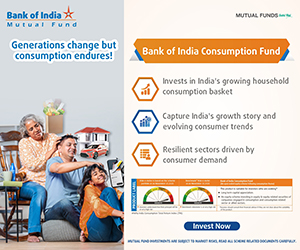Investing in the S&P 500 Top 50 Index will also allow Indian investors to benefit from rupee depreciation
BFSI Industry Interview

Mr. Srivastava has more than 10 years of experience in the field of financial services and stock markets. He has been associated with Mirae Asset Investment Managers (India) Private Limited from Sep 2018 till date with overall responsibilities of leading passive investment products.
You are launching S&P 500 Top 50 ETF. Please describe the salient features of this fund
Mirae Asset S&P 500 Top 50 ETF and Mirae Asset S&P 500 Top 50 ETF Fund of Fund intends to give investor a sector agnostic exposure to top 50 mega cap companies which are listed and deemed to be domiciled in United States by tracking S&P 500 Top 50 Index. The Index will be reconstituted on an annual basis.
Some of the salient features of this funds are as below:
- The S&P 500 Top 50 Index is designed to represent the performance of 50 US mega cap companies, across sectors, which are selected and weighted based on free float market cap from the parent S&P 500 index.
- The S&P 500 Top 50 Index captures several well-known sector leading companies from IT to health care, financials to consumer, energy to communication etc., having total market cap of over USD 23 Trillion which is more than 8 times the size of India's GDP.
- S&P 500 Top 50 (INR) has outperformed Nifty 50 by more than 10% in the last 10, 5, 3, 2 years period, respectively.
- Because of sector agnostic approach, the index has been relatively less volatile than tech centric index like NASDAQ 100 consistently in last 15 years.
- The index is reconstituted annually in the month of June. On an average in last 5 years, 4 companies have moved in and out of this index annually during reconstitution. This keeps index relevant as the companies and sector exposure in the index portfolio evolves as the US market evolves.
- Investing in the S&P 500 Top 50 Index will also allow Indian investors to benefit from rupee depreciation.
For retail investors who have only Indian equities in their investment portfolio, please explain the benefits of diversifying in international equities.
While India is one of the fastest growing economies of the world, it still represents merely 3% of the Gross Domestic Product (GDP) of the world (2019) and around 3% of total world stock market capitalization (2018). In today’s world of globalization, in which Indian investors are already a consumer of several global companies, such robust businesses also represent a prospect of being part of his/her investment portfolio. Also, in global markets, investors get access to emerging technologies and growing themes, like robotic and artificial intelligence, electric vehicle, cyber security, industrial automations, cloud computing, social media, e-commerce, fin-tech etc. These themes are expected to shape our future in coming times and therefore are increasingly becoming part of global investor's portfolio from long term point of view. Since Indian equities currently provide avenues of exposure majorly to old economy themes, one needs to look at global investable universe to participate in such mega-trends that are expected to transform the way we live and work
Different geographies represent different set of investment opportunities for investors. Every country or region is affected by various distinct factors. For instance, most of the developed economies are leading in terms of technological advancement whereas emerging economies such as India have huge growth potential supported by demographics. Since, the strength and weakness of each country differs, the equity markets behave differently and thus an India investor needs to look outwards to explore potential opportunities for wealth creation
In last decade we have witnessed that Indian equity market was not the best performing market. In Indian rupee Terms, in 7 out of last 10 calendar years, US markets have outperformed Indian markets. Thus, possibly those investors who were purely invested in Indian equity market would have underperformed vis-à-vis investors who had some allocation to United States in their portfolio. Diversifying globally is an excellent way to address the risk associated with “What if Indian equity market don’t do well?” and participate in global opportunities.
It is not just for wealth creation, but from a diversification point of view it has been observed that most of the global equity markets do not move in tandem and are very less correlated with Indian equity market. Further, when Indian investor invests in foreign assets he/she is exposed to currency fluctuations. When INR depreciates, the value of foreign asset increases and vice-versa. The value of Indian currency generally deprecates against developed economies over long term as the inflation in developed markets tends to be lower than inflation in India, and this also adds to the return of the investors
What is your outlook on the US market in the medium to long term?
Overall growth is looking strong across board this year in the United States. Massive fiscal stimulus, historically low interest rates and a huge pandemic-induced household savings provide a union of tailwinds. Much of that growth will be a catch-up from the damage caused in 2020 and the strong resurgence may continue well beyond pre-pandemic levels and through 2022.
If you see, growth in the second quarter (Q2 2021) was driven largely by consumer spending. Real personal consumption expenditures (PCE) shot up 11.8%, which was stronger than most analysts had expected and every major category of spending posted solid gains. While the economy is currently experiencing its peak rate of growth, we might see growth well-above trend as the economy continues to chip away at the output gap created by the pandemic. This is expected to provide additional room for growth.
- The forecasted GDP for the year 2021 (6.1%) and 2022 (4.1%) for United States are in line or expected to surpass the overall economic growth for all the advanced economies. The forecasted GDP growth of United States for the Year 2021 of 6.2% is almost equivalent to forecasted GDP growth of entire developing economies (which encompasses both India and China) and for the Year 2022 is 4.4% and is expected to surpass the GDP forecast of developing economies which is projected to rise by 3.8% in 2022.
- Households-particularly higher-income households-are sitting on a large pile of savings-about US$2.8 trillion more in Q1 2021 (Jan 2021 - Mar 2021) than expected under "normal" circumstances before the pandemic, driving the demand. The reopening of the consumer service sector is therefore likely to result in a burst of pent-up spending as people return to restaurants, theatres, sports events and travel (assuming COVID situation doesn't aggravate).
- Government spending will continue to support growth. The pandemic relief bills were instrumental in keeping the economy poised for growth, once economy open up. US Senate passing of $1 trillion infrastructure bill to be spend over decade is expected to boost the US Economy.
- As of August 13, 2021, 91% of the companies in the S&P 500 Index have reported actual revenue numbers for the second quarter. Of these companies, 87% reported actual revenues above the mean revenue estimate and 13% reported actual revenues below the mean revenue estimate. In aggregate, these companies reported revenues that were 4.9% above expectations best since 2008.
US macros looks good from medium to long term point of view, looking at all these parameters together, one can see the reason behind market optimism. Having said that, Indian investor may invest in US markets to take exposure in robust businesses which are sector/innovation leaders. The idea is to invest in a quality portfolio in either a sector agnostic manner or to track a sector or an emerging theme in the largest market in the world. Based on the investor's risk profile and aim of the investment, investor should choose the right space to invest in from a long-term point of view.
What are some of the risk factors for Indian investors looking to invest in US equities in the near to medium term?
First of all, investors should realize that global investments are exposed to several additional risk factors like country risk, currency risk, political and regulatory risk etc. of the concerned country or region. While markets like US have generated higher returns than Indian markets historically in certain periods, they are also are affected by such risk factors. So, investor should dace assess his risk profile and then look at the profile of the product and take an informed call.
Additional risk factors based on current market conditions are
- COVID concerns related to the Delta variant have re-emerged globally, which can create some downside risk to growth and could also weigh on financial market sentiment.
- Inflation is expected to continue to come in strong over the coming months amid ongoing supply constraints for still-solid demand. Inflation is likely to run above the FOMC's 2.0% target. While this seems to be transitionary in nature, it will be a concern if it continues for longer time.
- The minutes of the Fed's June monetary policy meeting indicated "substantial further progress" toward its goals had not yet been met, although policymakers also signalled they thought the conditions to begin slowing bond purchases might occur earlier than previously anticipated. Fed might formally announce tapering by its December FOMC policy meeting and kick it off late in 2021 or early in 2022. With that in mind, rate hikes look increasingly likely in 2023. Fed though seems to be cautious to avoid taper tantrum of 2013.
For the benefit of investors who do not have exposure to US or global equities, please describe the characteristics of the Top 50 companies in S&P 500.
These top 50 companies are largest not only in the United States but across the globe. These companies alone capture around 40% of the MSCI world index. These 50 companies are mega caps in terms of size and sector leaders ranging from healthcare to financials, IT to consumer discretionary, staples to energy etc. These companies have historically been able to demonstrate solid underlying growth in terms of sales and in earnings in the long-run. These companies constantly focus on reinventing themselves to maintain their competitive advantages with different product and services and continue their economic moat. These are well known companies even to Indian investors and several of them are part of our daily lives.
The combined market cap of these 50 companies is around USD 23 Tn which exceeds GDP of United States and almost 8x of India's GDP. The total combined revenue of these 50 companies is almost USD 4.2 Tn with net income of over USD 560 Bn. Because of the size and what these companies have been able to achieve till now, a portfolio constructed only focusing on these companies relatively tend to be more stable in terms of performance and volatility for investor. This has potential to become part of investors core international portfolio and can also be good way of starting somebody's global investment journey as you are investing in known names that have been able to establish their dominance across sector and over time, giving relative comfort to the investor.
What is your minimum recommended investment horizon for this ETF?
Investor can look at this fund as Nifty 50 of US market i.e. a sector agnostic product which will provide exposure to bluest of blue-chip, sector leading companies belonging to US mega cap space. Unlike Tech or sector centric product, the portfolio will evolve as sector and stock weightages will change depending upon the change in the US mega cap space
This product can become part of core international exposure that will complement existing domestic portfolio. If somebody is new to global investing, they can start participating in sector agnostic product like this and then move to certain niche and thematic offerings. If investor already has existing tech/sector exposure in US market, then one can add this product to their portfolio as it may be less risky and may have better downside protection than tech/sector products. Any core portfolio should be given sufficient amount of investment horizon so that meaningful impact can be created over one’s wealth creation journey. S&P 500 Top 50 ETF and Fund of Fund falls under this category and thus one should look for minimum investment horizon of at least 5 year.
Mutual fund investments are subject to market risks, read all scheme-related documents carefully.
Recent Interviews
-
Partner Connect by Advisorkhoj with Mr Amit Kalra Glorious Path Pvt Ltd New Delhi
Dec 5, 2025
-
Partner Connect by Advisorkhoj with Mr Alok Dubey PrimeWealth Pune
Dec 1, 2025
-
In Conversation by Advisorkhoj with Ms Aparna Shanker Chief Investment Officer Equity The Wealth Company Mutual Fund
Nov 28, 2025
-
In Conversation by Advisorkhoj with Mr Sanjay Bembalkar Head Equity Union MF
Nov 28, 2025
-
In Conversation by Advisorkhoj with Mr Arjun Khanna Equity Fund Manager Kotak Mutual Fund
Nov 17, 2025
Fund News
-
DSP Mutual Fund launches DSP Nifty Next 50 ETF
Dec 19, 2025 by Advisorkhoj Team
-
DSP Mutual Fund launches DSP Nifty 500 Index Fund
Dec 19, 2025 by Advisorkhoj Team
-
Kotak Mahindra Mutual Fund launches Kotak Nifty Next 50 ETF
Dec 18, 2025 by Advisorkhoj Team
-
The Wealth Company Mutual Fund launches The Wealth Company Gold ETF
Dec 16, 2025 by Advisorkhoj Team
-
Axis Mutual Fund launches Axis Gold and Silver Passive FOF
Dec 10, 2025 by Advisorkhoj Team





